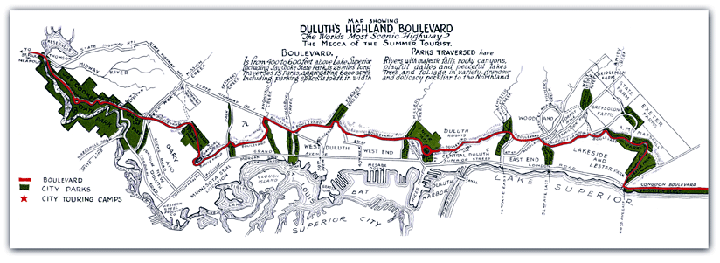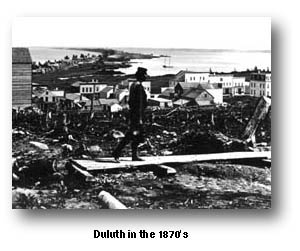

In 1888,
a year before the city's park board's creation, Rogers presented
to the council an ingenious park design utilizing Duluth's unique
topography. The centerpiece of the system would be a city-wide
boulevard built across the hilltop, along the natural terrace.

Geological profile of section at the head of 9th Avenue West in Duluth, Minn. Note how the early boulevard (Carriage Drive) was created out of a natural terrace left by Lake Superior's prehistoric beach. (Winchell, Geol. & Nat. Hist. Survey of MN, 1896-98)
The plan included a lakeshore park stretching
along the present shoreline from 7th Avenue East to 40th Avenue
East, and called for the two parallel park systems to be occasionally
connected by perpendicular ravine park systems which followed
the city's many rivers and creeks as  they
plunged toward the lake. Rogers had first conceived the plan twelve
years before in 1875.
they
plunged toward the lake. Rogers had first conceived the plan twelve
years before in 1875.
Duluth began experiencing a real estate boom
in the late 1880's, and Rogers along with city officials foresaw
a population growth of nearly half a million within five years.
A park system such as the one Rogers had laid out was considered
an essential advertising tool for the city. Rogers expressed his
thoughts about it in a letter to former president Hayes:
Olaf Benson, a landscape engineer who had done so much for Chicago parks was invited by Rogers to visit Duluth and give his thoughts on the city's potential for park building.
"It is the most wonderful opportunity for city parking which I know of in any country. The fact that there exists in the very heart of the city such a ground-work for a park system is really phenomenal. Other cities have had to create their parks. Duluth has hers ready made." --Olaf Benson, Chicago Landscape Engineer
 For twenty years
Benson had overseen the improvements of Lincoln Park in Chicago.
He came to Duluth because of his interest in projects such as
Duluth had in the works. He was even more enthusiastic about the
layout of the upper terrace.
For twenty years
Benson had overseen the improvements of Lincoln Park in Chicago.
He came to Duluth because of his interest in projects such as
Duluth had in the works. He was even more enthusiastic about the
layout of the upper terrace.
"I have seen nothing approaching it in this country, or in foreign lands in all my experience, for the purpose for which it is wanted--an absolutely perfect road, graded and macadamized by nature up nearly 500 feet above the level of the lake overlooking the city and commanding a view in every direction of its superb surrounds, that Duluth may well be proud of, and should not fail to show every visitor. The city, I think, should recognize that it holds such a gift of nature in trust--to develop it in every appropriate way."